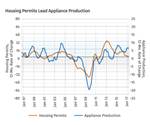Construction Spending Slowing, But Outlook Remains Strong
The short-term trend is neutral to slightly negative, but leading indicators are starting to move in a positive direction.
In March, total construction spending was growing at its slowest rate since September 2016 and second slowest rate since December 2011. The 10-yr U.S. Treasury bond interest rate is neutral for future construction spending, while housing permits are a slightly positive leading indicator.
Real 10-Yr Treasury Rate. The real (inflation-adjusted) 10-yr Treasury rate was 0.85% in March, which was the third straight month of decreases. It was the lowest rate since October. The nominal rate was 2.48%, which was relatively unchanged for the fourth month in a row. But the rate of inflation was above 2% for the fourth consecutive month. Increasing inflation is depressing the real 10-yr Treasury rate, even though the nominal rate has remained fairly steady (the real rate is the nominal rate minus inflation). The year-over-year change in the real rate decreased to -63 basis points (a basis point is 1/100th of a percent). That ended four straight months of increase. The year-over-year change in the real rate has not moved much the last four months.
Housing Permits. March saw 111,900 housing permits filed, the highest level since June 2016 and the second-highest level since June 2015. Compared with a year ago, housing permits increased 14.5%. This was the third straight month of growth and the seventh in the last eight months. Also, permits grew faster than 14% in two of the last three months. The annual rate of growth accelerated to 1%, which was the fastest rate since November 2016.
The change in the real 10-yr Treasury rate is a likely cause for the September increase in housing permits. Changes in the interest rate generally lead changes in housing permits by about 12 months.
Total Construction Spending. The real value of construction put in place in March was $92.954 million. Compared with one year ago, this was an increase of just 0.9%. The month-over-month rate of change has grown at a decelerating rate since November 2016. The annual rate of change peaked in March 2016 and has grown at a decelerating rate since then. Annual construction spending is growing at a rate of 3.3%, which is the slowest since August 2012.
On the other hand, residential construction spending has grown at an accelerating rate in the last two months. Month-over-month growth accelerated to 5.5% in March. The annual rate of growth, now 4.6%, has decelerated for 15 months in a row and was the slowest since October 2012.
Short term, the trend in construction spending is neutral to slightly negative for products, parts, and production of equipment used in the industry. However, the change in the real 10-yr Treasury rate and the change in housing permits are starting to move in a positive direction.
ABOUT THE AUTHOR: Steven Kline Jr. is part of the fourth-generation ownership team of Cincinnati-based Gardner Business Media, which is the publisher of Plastics Technology. He is currently the company’s director of market intelligence. Contact: (513) 527-8800 email: skline2@gardnerweb.com; blog: gardnerweb.com/economics/blog
Related Content
-
Plastics Machinery Shipments Rose in 2022’s Final Quarter
The Plastics Industry Association’s (PLASTICS) Committee on Equipment Statistics (CES) reported that injection molding and extrusion machinery shipments totaled $432.7 million in Q4.
-
Advanced Drainage Systems to Build New Florida Manufacturing Facility
New manufacturing facility will complement other ADS facilities in the southeast region.
-
LyondellBasell Showcasing End-Use Applications in 5 Key Markets
NPE2024: LYB is highlighting applications in circularity, mobility and transportation, food and medical, consumer goods/lifestyle, and infrastructure/building and construction.

.JPG;width=70;height=70;mode=crop)











